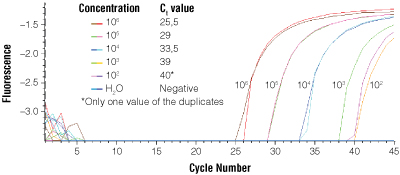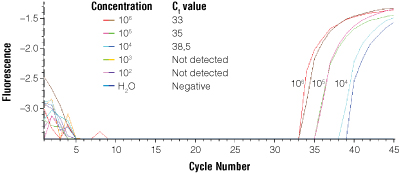Automated DNA Extraction from Environmental Soil Samples Using the Maxwell® 16 System
Bundeswehr Research Institute for Protective Technologies and NBC Protection, P.O. 1142, 29623 Munster, Germany.
Publication Date: 2010
Abstract
This article describes an automated, time-saving and effective way to isolate Bacillus anthracis DNA from soil samples. The isolated DNA was used in quantitative, real-time PCR. This article first appeared in BIOspektrum magazine, and is reproduced here with permission of the Authors and Editors.
Introduction
Bacillus anthracis constitutes a significant terrorist threat potential. Therefore, military and civilian institutions have become increasingly interested in the detection of B. anthracis DNA directly from environmental samples such as soil. Soils contain abundant humic and fulvic acids, and the co-extraction of these enzymatic inhibitors during DNA-isolation can interfere with restriction enzyme digestion, transformation efficiency and subsequent PCR. In this article, we show that DNA from B. anthracis can be effectively and reliably purified from soil samples using the Maxwell® 16 Instrument and the DNA IQ Casework Kit (Cat.# AS1240). We were able to get reliable results in quantitative real-time PCR using the purified DNA.
Materials and Methods
Bacillus anthracis, the causative agent of Anthrax, is a Gram-positive, spore-forming, rod-shaped bacterium. In these experiments we used vegetative cells of an attenuated, inactivated B. anthracis (Sterne) strain.
To evaluate the DNA extraction method, we used two different standard soils (2.2 loamy sand, Chrg.: 4405, and 2.3 sandy loam, Chrg.: 2900). Both soil types had been collected and characterized by the Landwirtschaftliche Untersuchungs- und Forschungsanstalt Speyer (LUFA). The soils differed in their organic carbon content (soil 2.2: 2,33 % and soil 2.3: 0,7 %) and pH-values (soil 2.2: 5.7 and soil 2.3: 6.5).
Soil samples (500 mg) were inoculated with 400 µl of varying concentrations (106; 105; 104; 103 and 102 cells) of an inactivated, vegetative B. anthracis Sterne cell suspension. As a negative control, soil was inoculated with the same volume of sterile HPLC-water. After homogenization, 400 µl of DNA IQ Casework Lysis Buffer (supplied with the DNA IQ Casework Sample Kit for Maxwell® 16) was added to each sample and mixed. The samples were incubated for 10 minutes at 95°C, mixed carefully then centrifuged at 10,000 rpm for 2 minutes. The soil-free supernatant was transferred to well #1 of the DNA IQ Casework Cartridge and processed using the Maxwell® 16 LEV instrument. The DNA extraction was run in the forensic mode, and the elution volume was 200 µl for each sample.
Two microliters of the eluted DNA was analysed in duplicate using a BioRad DNA Engine Opticon Real-Time PCR Detection System. Real-Time PCR was performed using HotStar Taq DNA Polymerase (QIAGEN), target-specific primers and a TaqMan probe specific for the B. anthracis PA (protective antigen) gene, using 45 reaction cycles. Different dilutions of vegetative B. anthracis Sterne cells served as a positive control. An amplification control was performed simultaneously to examine the isolated DNA for co-eluted humic acids and other inhibitors. For the amplification control reaction, 2 µl of the isolated B. anthracis DNA samples were added to a non B. anthracis real-time PCR reaction.
Results and Discussion
Following extraction from soil 2.2, B. anthracis DNA could be detected via real-time PCR at different concentrations. We were able to detect as few as 103 cells in 500 mg soil (Figure 1). Furthermore, the Ct values were comparable to those values of the corresponding positive controls (data not shown). As all amplification controls showed the same signal as the positive control, no PCR inhibitors were co-purified (data not shown).
 Figure 1. Real-time PCR of extracted DNA from soil 2.2 containing B. anthracis cells.
Figure 1. Real-time PCR of extracted DNA from soil 2.2 containing B. anthracis cells.
Following extraction from loamy sand (soil type 2.3) 104 cells in 500 mg soil were detected (Figure 2). No inhibitory substances were indicated in the amplification control (data not shown).
 Figure 2. Real-time PCR of extracted DNA from 106-102 B. anthracis cells.
Figure 2. Real-time PCR of extracted DNA from 106-102 B. anthracis cells.
Both experiments were repeated several times and resulted in similar Ct values (data not shown). Furthermore, DNA extraction was also performed successfully using other standard soils from LUFA.
Conclusion
We successfully extracted B. anthracis DNA from two different standard soil types using the automated Maxwell® 16 System and the DNA IQ Casework Sample Kit. No pre-treatment was required. The purified DNA was amplified reliably in a quantitative real-time PCR assay. Co-extraction of humic and fluvic acids could not be detected in amplification control reactions. This application is an automated, time saving and effective way to isolate DNA from soil samples.
Acknowledgement
We would like to thank Bärbel Niederwöhrmeier for preparation and inactivation of B. anthracis Sterne.
Related Products
How to Cite This Article
Scientific Style and Format, 7th edition, 2006
Zoll G, Maatmann I, Grote G and Köhne S. Automated DNA Extraction from Environmental Soil Samples Using the Maxwell® 16 System. [Internet] 2010 . [cited: year, month, date]. Available from: https://www.promega.com/es-es/resources/pubhub/automated-dna-extraction-from-environmental-soil-samples-using-the-maxwell-16-system/
American Medical Association, Manual of Style, 10th edition, 2007
Zoll G, Maatmann I, Grote G and Köhne S. Automated DNA Extraction from Environmental Soil Samples Using the Maxwell® 16 System. Promega Corporation Web site. https://www.promega.com/es-es/resources/pubhub/automated-dna-extraction-from-environmental-soil-samples-using-the-maxwell-16-system/ Updated 2010 . Accessed Month Day, Year.
Maxwell is a registered trademark of Promega Corporation. DNA IQ is a trademark of Promega Corporation.
HotStar is a registered trademark of QIAGEN. Opticon is a registered trademark of Bio-Rad Laboratories, Inc. TaqMan is a registered trademark of Roche Molecular Systems, Inc.